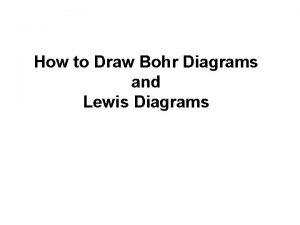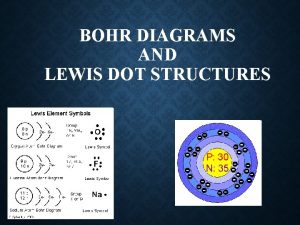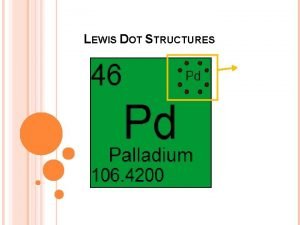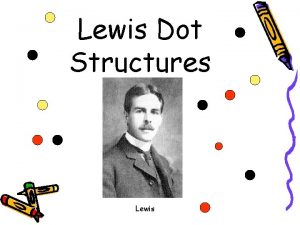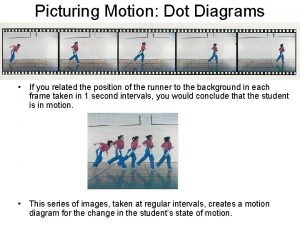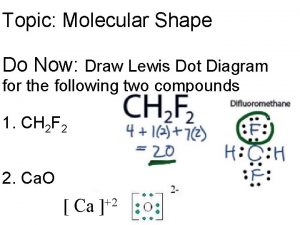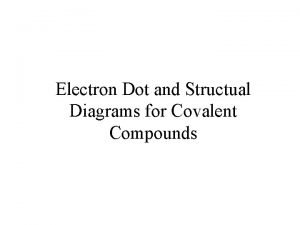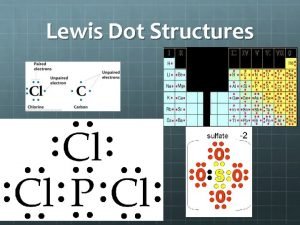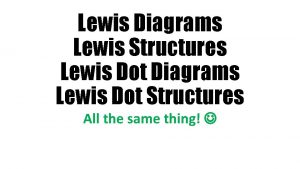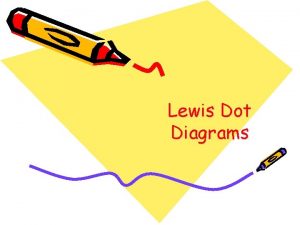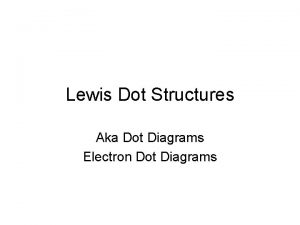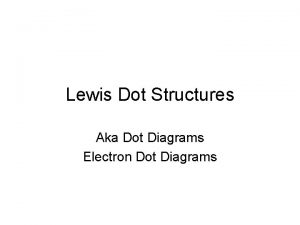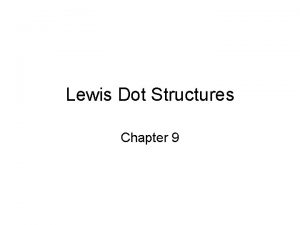Lewis Structures Molecular Geometries Lewis Dot Diagrams Represent
















- Slides: 16

Lewis Structures & Molecular Geometries

Lewis Dot Diagrams • Represent the valence e- for an atom using dots. • Start at the top and place e- on each side going clockwise. Once there are e- on each side, begin to pair them up. Sodium 1 valence e- Magnesium 2 valence e-

Aluminum 3 valence e- Silicon 4 valence e- Phosphorus 5 valence e- Sulfur 6 valence e- Chlorine 7 valence e- Argon 8 valence e-

Elements in the same family have the same number of valence e- and the same Lewis dot arrangement

2/24/11 • Essential Question: Why do molecules have specific compositions and shapes? • Warm-up: Write the chemical formula for the structure below:

Bonding Using Lewis Dot Diagrams and Share a pair of e- to form So that each atom has a full outer energy level A pair of shared e- can also be represented with a dashed line.

Exceptions to the Octet Rule • In covalent bonds, atoms always share e- to reach a full valence shell of 8 valence e-…except… – Hydrogen only needs 2 e- in its outer energy level. – Boron only needs 6 e- in its outer energy level. – Some elements can form an expanded octet using empty d-orbitals to form bonds and have more than 8 valence e-.

5 Steps for Drawing Lewis Structures 1. Count the total number of valence electrons for all atoms. 2. Attach each atom to the central atom with a single bond (single bond = 2 shared electrons) 3. Complete the octet for the attached atoms by adding pairs of non-bonding electrons. 4. Complete the octet for the central atom by adding pairs of non-bonding electrons

5. Count the total number of electrons in your structure and compare to step one. – If the number of e- is the same, it is correct. – If you used too many e-, add double bond(s) and check your total again (usually add one double bond for each two electrons that you are over the total). – If there are extra electrons left over, add them as non-bonding electrons on the central atom. This is called an expanded octet.

Warm-Up 2/25/11 • Complete Part 6 of Activity 2 B.

Valence Shell Electron Pair Repulsion Theory • Abbreviated “VSEPR” • Pairs of e- around an atom repel each other and will form an arrangement that minimizes this repulsion (i. e. spread as far apart from each other as possible). As a result, molecules tend to form predictable shapes. • Lone pairs of non-bonding e- have greater repulsion than bonded pairs of e-.

Prefixes Prefix Mono. Di. Tri. Tetra. Penta. Hexa. Septa. Octa- Number 1 2 3 4 5 6 7 8

Molecular Geometry- Shapes • Tetrahedral- a shape formed when a central atom is bonded to four other atoms that all point into the corners of a tetrahedron. – Example: CH 4 • Trigonal Planar- a shape formed when a central atom has no lone pair electrons and is bonded to three other atoms. – Example: CCl 2 O • Trigonal Pyramidal- a shape formed when a central atom has one unshared pair of electrons and is bonded to three other atoms. – Example: NH 3

Shapes (continued) • Linear- a shape formed when a central atom has no lone pair electrons and is bonded to two other atoms – Example: CO 2 • Bent- a shape formed when a central atom has two unshared pairs of electrons and is bonded to two other atoms. – Example: H 2 O

Basic VSEPR Geometries Molecular Geometry ABE Notation Atoms bonded to Non-bonding pairs the central atom on the central atom Tetrahedral AB 4 4 0 Trigonal Pyramid AB 3 E 3 1 Bent AB 2 E 2 or AB 2 E 2 1 or 2 Linear AB 2 2 0 Trigonal Planar AB 3 3 0

Expanded Octet Geometries Molecular Geometry ABE Notation Atoms bonded to the central atom Non-bonding pairs on the central atom Octahedral AB 6 6 0 Square Pyramid Square Planar Trigonal Bipyramid Seesaw AB 5 E AB 4 E 2 AB 5 5 4 5 1 2 0 AB 4 E 4 1 T-Shaped Linear AB 3 E 2 AB 2 E 4 3 2 2 4
 Polar vsepr shapes
Polar vsepr shapes Lithium lewis dot structure
Lithium lewis dot structure Mono di tri tetra
Mono di tri tetra Id root
Id root Review bohr and lewis dot diagrams
Review bohr and lewis dot diagrams F2 bohr diagram
F2 bohr diagram Polyatomic ion lewis structures
Polyatomic ion lewis structures Theory of structures
Theory of structures Lewis dot structure trigonal pyramidal
Lewis dot structure trigonal pyramidal Electron dot diagram
Electron dot diagram The interaction diagrams, use case diagrams are called as
The interaction diagrams, use case diagrams are called as Activity diagrams are static diagrams
Activity diagrams are static diagrams Constant velocity dot diagram
Constant velocity dot diagram Dot diagrams
Dot diagrams Dot diagrams
Dot diagrams Covalent bond boiling point
Covalent bond boiling point Giant molecular structure vs simple molecular structure
Giant molecular structure vs simple molecular structure

